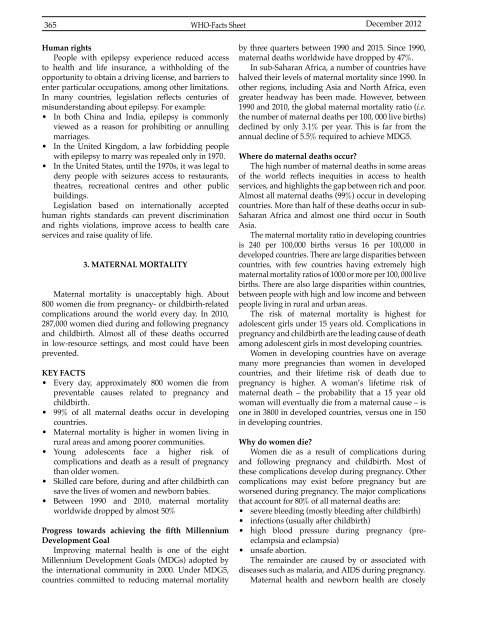Vol 44 # 4 December 2012 - Kma.org.kw
Vol 44 # 4 December 2012 - Kma.org.kw
Vol 44 # 4 December 2012 - Kma.org.kw
You also want an ePaper? Increase the reach of your titles
YUMPU automatically turns print PDFs into web optimized ePapers that Google loves.
365<br />
WHO-Facts Sheet <strong>December</strong> <strong>2012</strong><br />
Human rights<br />
People with epilepsy experience reduced access<br />
to health and life insurance, a withholding of the<br />
opportunity to obtain a driving license, and barriers to<br />
enter particular occupations, among other limitations.<br />
In many countries, legislation reflects centuries of<br />
misunderstanding about epilepsy. For example:<br />
• In both China and India, epilepsy is commonly<br />
viewed as a reason for prohibiting or annulling<br />
marriages.<br />
• In the United Kingdom, a law forbidding people<br />
with epilepsy to marry was repealed only in 1970.<br />
• In the United States, until the 1970s, it was legal to<br />
deny people with seizures access to restaurants,<br />
theatres, recreational centres and other public<br />
buildings.<br />
Legislation based on internationally accepted<br />
human rights standards can prevent discrimination<br />
and rights violations, improve access to health care<br />
services and raise quality of life.<br />
3. MATERNAL MORTALITY<br />
Maternal mortality is unacceptably high. About<br />
800 women die from pregnancy- or childbirth-related<br />
complications around the world every day. In 2010,<br />
287,000 women died during and following pregnancy<br />
and childbirth. Almost all of these deaths occurred<br />
in low-resource settings, and most could have been<br />
prevented.<br />
KEY FACTS<br />
• Every day, approximately 800 women die from<br />
preventable causes related to pregnancy and<br />
childbirth.<br />
• 99% of all maternal deaths occur in developing<br />
countries.<br />
• Maternal mortality is higher in women living in<br />
rural areas and among poorer communities.<br />
• Young adolescents face a higher risk of<br />
complications and death as a result of pregnancy<br />
than older women.<br />
• Skilled care before, during and after childbirth can<br />
save the lives of women and newborn babies.<br />
• Between 1990 and 2010, maternal mortality<br />
worldwide dropped by almost 50%<br />
Progress towards achieving the fifth Millennium<br />
Development Goal<br />
Improving maternal health is one of the eight<br />
Millennium Development Goals (MDGs) adopted by<br />
the international community in 2000. Under MDG5,<br />
countries committed to reducing maternal mortality<br />
by three quarters between 1990 and 2015. Since 1990,<br />
maternal deaths worldwide have dropped by 47%.<br />
In sub-Saharan Africa, a number of countries have<br />
halved their levels of maternal mortality since 1990. In<br />
other regions, including Asia and North Africa, even<br />
greater headway has been made. However, between<br />
1990 and 2010, the global maternal mortality ratio (i.e.<br />
the number of maternal deaths per 100, 000 live births)<br />
declined by only 3.1% per year. This is far from the<br />
annual decline of 5.5% required to achieve MDG5.<br />
Where do maternal deaths occur?<br />
The high number of maternal deaths in some areas<br />
of the world reflects inequities in access to health<br />
services, and highlights the gap between rich and poor.<br />
Almost all maternal deaths (99%) occur in developing<br />
countries. More than half of these deaths occur in sub-<br />
Saharan Africa and almost one third occur in South<br />
Asia.<br />
The maternal mortality ratio in developing countries<br />
is 240 per 100,000 births versus 16 per 100,000 in<br />
developed countries. There are large disparities between<br />
countries, with few countries having extremely high<br />
maternal mortality ratios of 1000 or more per 100, 000 live<br />
births. There are also large disparities within countries,<br />
between people with high and low income and between<br />
people living in rural and urban areas.<br />
The risk of maternal mortality is highest for<br />
adolescent girls under 15 years old. Complications in<br />
pregnancy and childbirth are the leading cause of death<br />
among adolescent girls in most developing countries.<br />
Women in developing countries have on average<br />
many more pregnancies than women in developed<br />
countries, and their lifetime risk of death due to<br />
pregnancy is higher. A woman’s lifetime risk of<br />
maternal death – the probability that a 15 year old<br />
woman will eventually die from a maternal cause – is<br />
one in 3800 in developed countries, versus one in 150<br />
in developing countries.<br />
Why do women die?<br />
Women die as a result of complications during<br />
and following pregnancy and childbirth. Most of<br />
these complications develop during pregnancy. Other<br />
complications may exist before pregnancy but are<br />
worsened during pregnancy. The major complications<br />
that account for 80% of all maternal deaths are:<br />
• severe bleeding (mostly bleeding after childbirth)<br />
• infections (usually after childbirth)<br />
• high blood pressure during pregnancy (preeclampsia<br />
and eclampsia)<br />
• unsafe abortion.<br />
The remainder are caused by or associated with<br />
diseases such as malaria, and AIDS during pregnancy.<br />
Maternal health and newborn health are closely
















